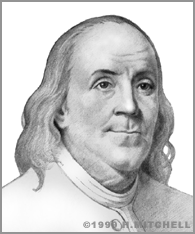Benjamin Franklin
Benjamin Franklin was probably the most significant “founding father” of the United States of America who never served as its President. But he was much more than a statesman. He was a man of letters, a publisher, a philosopher, a scientist, and the first major American inventor.
Franklin was born in Boston in 1706. At age 12, he was apprenticed to his older brother James, a printer, but Franklin resented being ordered about from his brother. Five years later, he virtually ran away from home. He moved to Philadelphia, then London, then back to Philadelphia, where he established his own printing office in 1728. Like his contemporary inventor Benjamin Banneker, Franklin used his polymathic knowledge to publish an almanac called “Poor Richard: An Almanack” (1732-1758).
In 1748, Franklin retired from printing in order to devote himself fully to various aspects of biology and physics that had captivated him for some time. His most famous experiment, of course, was flying a kite with a key attached to its string, proving that lightning carries an electrical charge (1752). By then, Franklin had already invented the lightning rod, which he primarily intended for use atop ships, not houses.
After he reached 40 years old, Franklin needed to wear glasses for reading as well as for everyday nearsightedness. In order to save himself the trouble of constantly switching between two pairs, he cut the lenses in half horizontally and joined the tops of his everyday lenses to the bottoms of his reading glasses, thereby inventing the world’s first bifocal glasses.
Franklin also conceived the mid-room furnace, the “Franklin Stove.” In those days, rooms could only be heated with a fire in a fireplace, which by definition was set into a wall. Franklin knew that since heat radiates from a fire in all directions, a fireplace was inefficient. So he built a cast-iron furnace that could be placed in the middle of a room. The heat that it generated spread out in all directions and was also absorbed by the furnace’s iron walls so that the stove provided warmth even after the fire went out.
However, Franklin’s design was flawed in that his furnace vented the smoke from its base. The furnace lacked a chimney to “draw” fresh air up through the central chamber, so the fire would soon go out. It took David R. Rittenhouse, another hero of early Philadelphia, to improve Franklin’s design by adding an L-shaped exhaust pipe that drew air through the furnace and vented its smoke up and along the ceiling, then into an intramural chimney and out of the house.
Franklin’s other inventions include an odometer and the first known medical catheter. In addition, he first conceived a number of institutions, including the American Philosophical Society (1728), the first American Fire Department (1736), and what later became the University of Pennsylvania (1742). He was Philadelphia’s first Postmaster General (1736) and, of course, played a major role in the formation of the United States of America. One of the last roles he played before his death at age 84 in 1790 was as the President of the Pennsylvania Society for Promoting the Abolition of Slavery.
Benjamin Franklin was a true philosopher in the earliest sense of the word. He was interested in all aspects of the natural world, including mankind’s place in it, he learned through his own experimentation and his conversation with those who shared his interests, and he showed little interest in patenting or profiting from the things he invented and discovered. Scientifically speaking, he may be the best role model that 21st-century American inventors could find.


